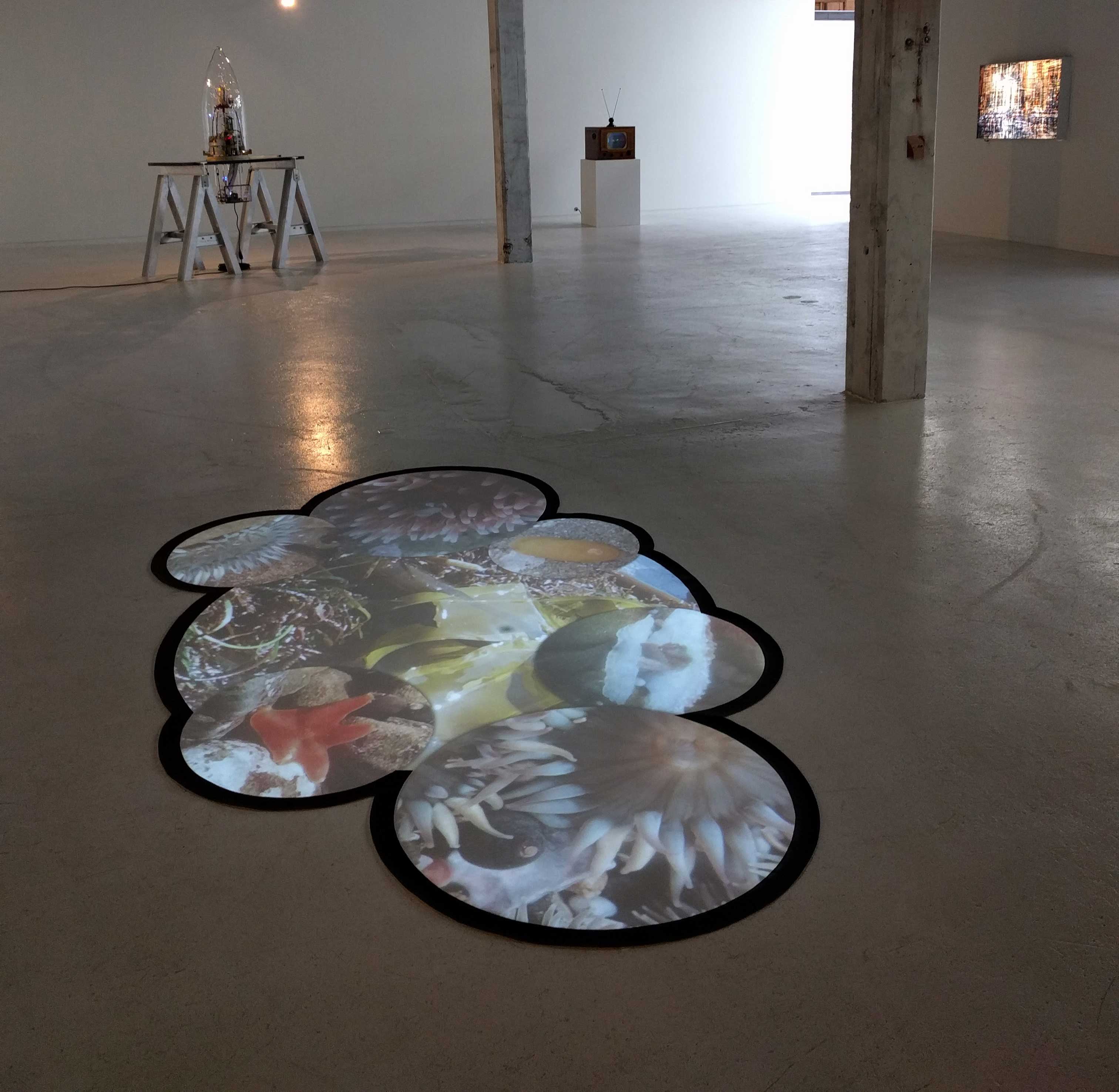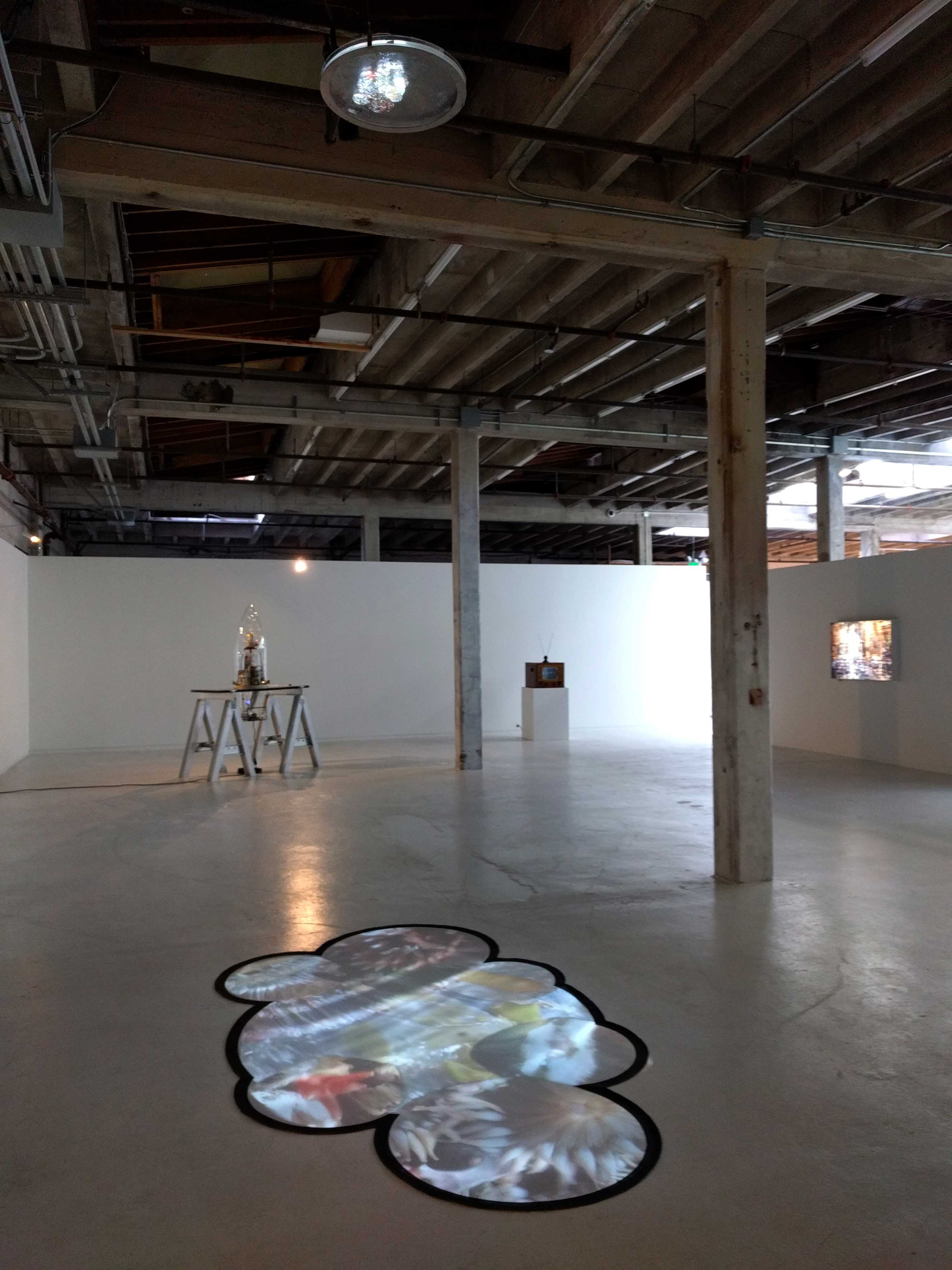Pool is finally up at Hosfelt Gallery. Well… it’s been up for two weeks, but I’m just getting  around to posting some photos. So here’s how it works: Pool was shot in the tide pools of Salt Point from late January through April of this year. The video is projected onto the floor, passing through a large dish just below the projector holding about six liters of water. The central video shows a round pool of waves washing seaweed onto the shore, and you can hear the waves lapping over and over. Six round videos surround this central image, each representing a tide pool. Some of the pools show a wide shot of activity, a few are macro close-ups, one is primarily red creatures. There are two other sounds: seagulls and fog horns. The gulls and the foghorns are triggered by electronics, which in turn trigger motors fitted with paddles, which in turn churn the water, which in turn distorts the video with wave patterns. The gulls and fog horns sound infrequently, and give the sensation of peering through the waves.
around to posting some photos. So here’s how it works: Pool was shot in the tide pools of Salt Point from late January through April of this year. The video is projected onto the floor, passing through a large dish just below the projector holding about six liters of water. The central video shows a round pool of waves washing seaweed onto the shore, and you can hear the waves lapping over and over. Six round videos surround this central image, each representing a tide pool. Some of the pools show a wide shot of activity, a few are macro close-ups, one is primarily red creatures. There are two other sounds: seagulls and fog horns. The gulls and the foghorns are triggered by electronics, which in turn trigger motors fitted with paddles, which in turn churn the water, which in turn distorts the video with wave patterns. The gulls and fog horns sound infrequently, and give the sensation of peering through the waves.
Pool is related to other recent works all made in the same area, in which I’m trying to learn to see – to see and to understand. I’ve spent a few decades in the area of Salt Point, but I feel like I’m only just beginning to understand the density and complexity of life there. Secondarily, the work is about the fragility and resiliency of that life. The

intertidal zone is a fascinating space between the high and low tides of oceans around the world. It’s a harsh space, subject to constant extremes, and exists in constant oscillation between dry exposure and salty inundation. It seems like a space filled with evolutionary experimentation, but it’s also a highly structured space. Each species fills a specific niche between high and low, wet and dry, exposed and hidden, hot and cold, still and rushing. Each of those narrow zones is susceptible to incessant tidal and seasonal changes. With rising and warming oceans, that’s a recipe for disaster. Many of these species can’t move easily or quickly, some can’t move at all once they become adults (mussels, barnacles, seaweed, etc).
 around to posting some photos. So here’s how it works: Pool was shot in the tide pools of Salt Point from late January through April of this year. The video is projected onto the floor, passing through a large dish just below the projector holding about six liters of water. The central video shows a round pool of waves washing seaweed onto the shore, and you can hear the waves lapping over and over. Six round videos surround this central image, each representing a tide pool. Some of the pools show a wide shot of activity, a few are macro close-ups, one is primarily red creatures. There are two other sounds: seagulls and fog horns. The gulls and the foghorns are triggered by electronics, which in turn trigger motors fitted with paddles, which in turn churn the water, which in turn distorts the video with wave patterns. The gulls and fog horns sound infrequently, and give the sensation of peering through the waves.
around to posting some photos. So here’s how it works: Pool was shot in the tide pools of Salt Point from late January through April of this year. The video is projected onto the floor, passing through a large dish just below the projector holding about six liters of water. The central video shows a round pool of waves washing seaweed onto the shore, and you can hear the waves lapping over and over. Six round videos surround this central image, each representing a tide pool. Some of the pools show a wide shot of activity, a few are macro close-ups, one is primarily red creatures. There are two other sounds: seagulls and fog horns. The gulls and the foghorns are triggered by electronics, which in turn trigger motors fitted with paddles, which in turn churn the water, which in turn distorts the video with wave patterns. The gulls and fog horns sound infrequently, and give the sensation of peering through the waves. intertidal zone is a fascinating space between the high and low tides of oceans around the world. It’s a harsh space, subject to constant extremes, and exists in constant oscillation between dry exposure and salty inundation. It seems like a space filled with evolutionary experimentation, but it’s also a highly structured space. Each species fills a specific niche between high and low, wet and dry, exposed and hidden, hot and cold, still and rushing. Each of those narrow zones is susceptible to incessant tidal and seasonal changes. With rising and warming oceans, that’s a recipe for disaster. Many of these species can’t move easily or quickly, some can’t move at all once they become adults (mussels, barnacles, seaweed, etc).
intertidal zone is a fascinating space between the high and low tides of oceans around the world. It’s a harsh space, subject to constant extremes, and exists in constant oscillation between dry exposure and salty inundation. It seems like a space filled with evolutionary experimentation, but it’s also a highly structured space. Each species fills a specific niche between high and low, wet and dry, exposed and hidden, hot and cold, still and rushing. Each of those narrow zones is susceptible to incessant tidal and seasonal changes. With rising and warming oceans, that’s a recipe for disaster. Many of these species can’t move easily or quickly, some can’t move at all once they become adults (mussels, barnacles, seaweed, etc).